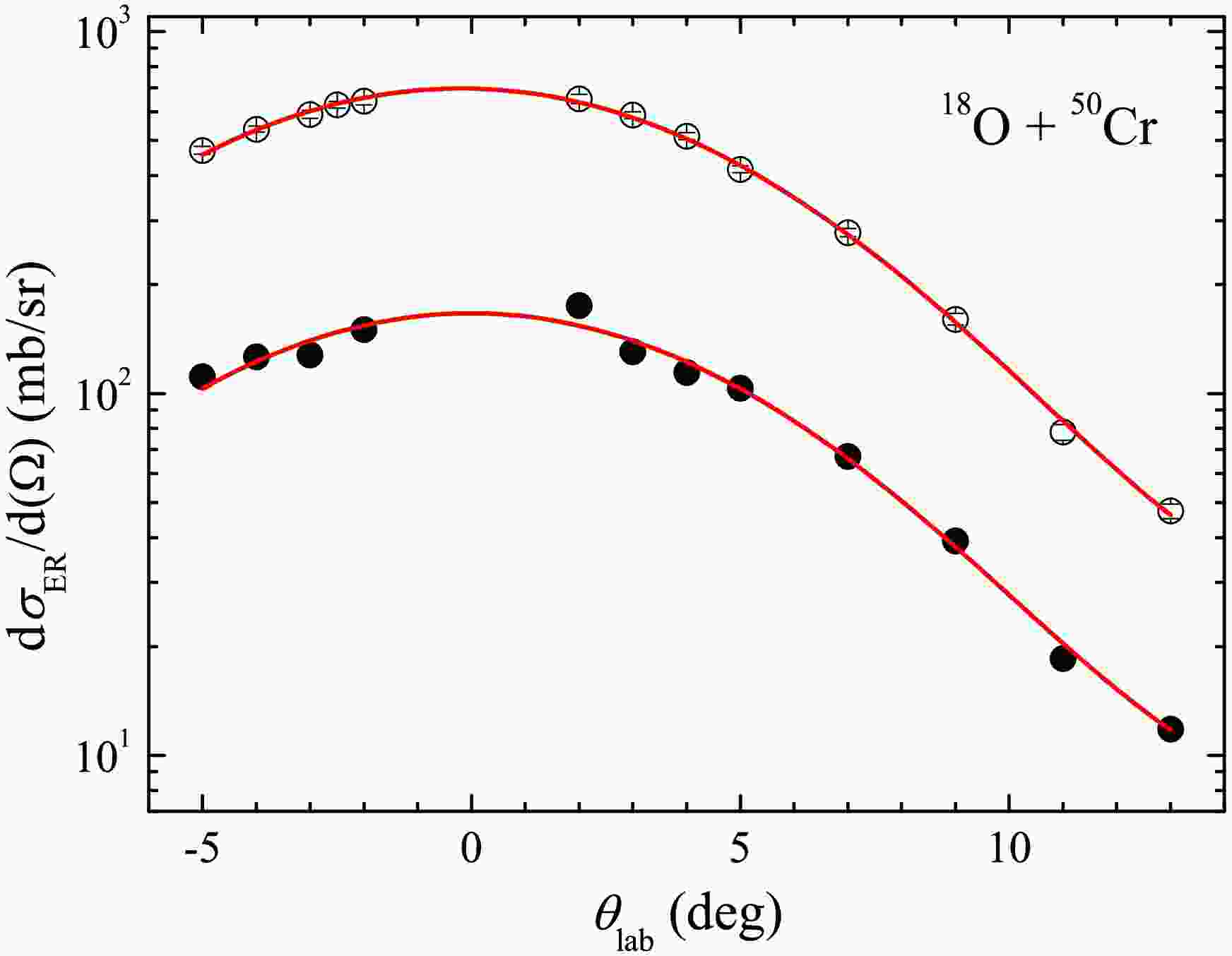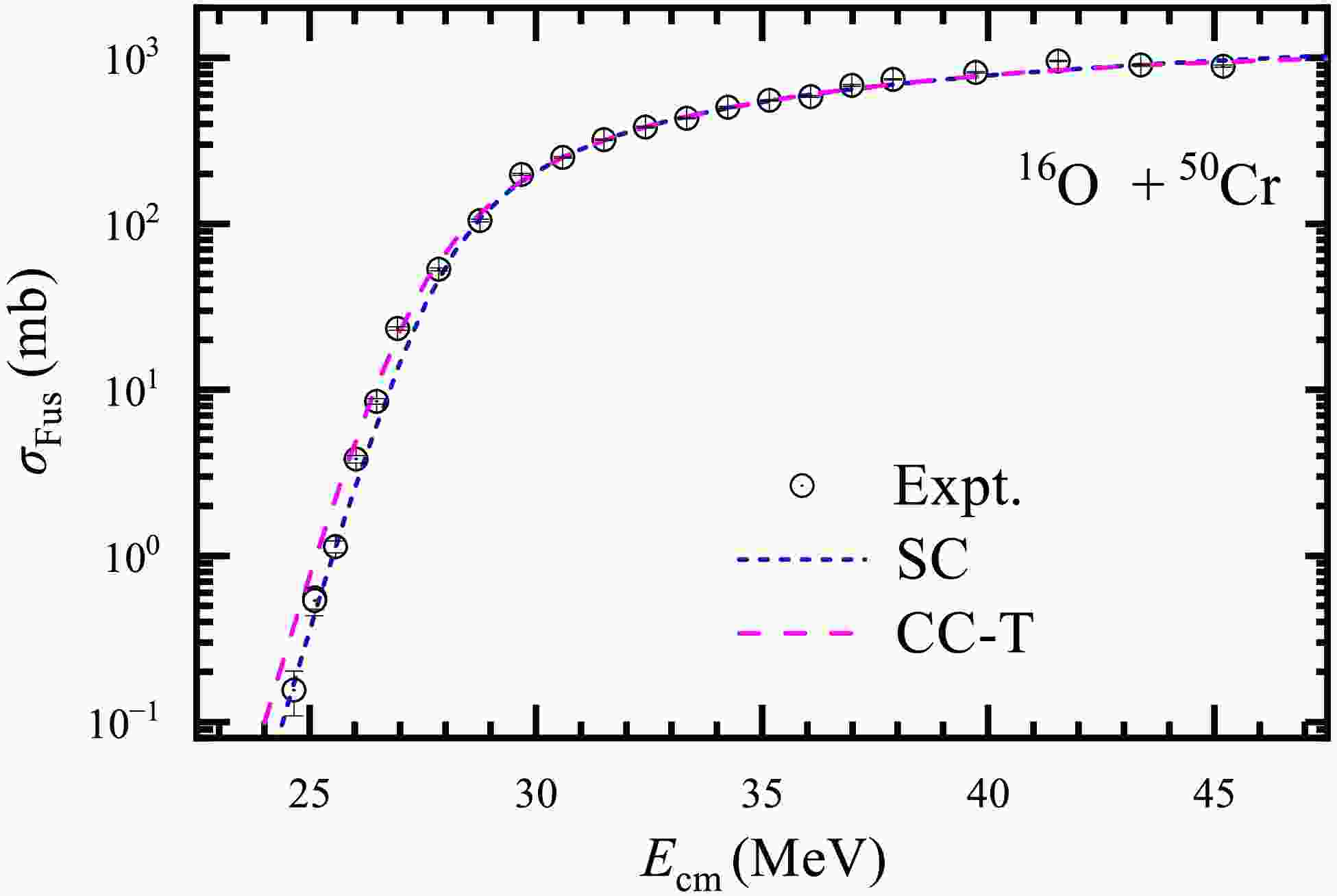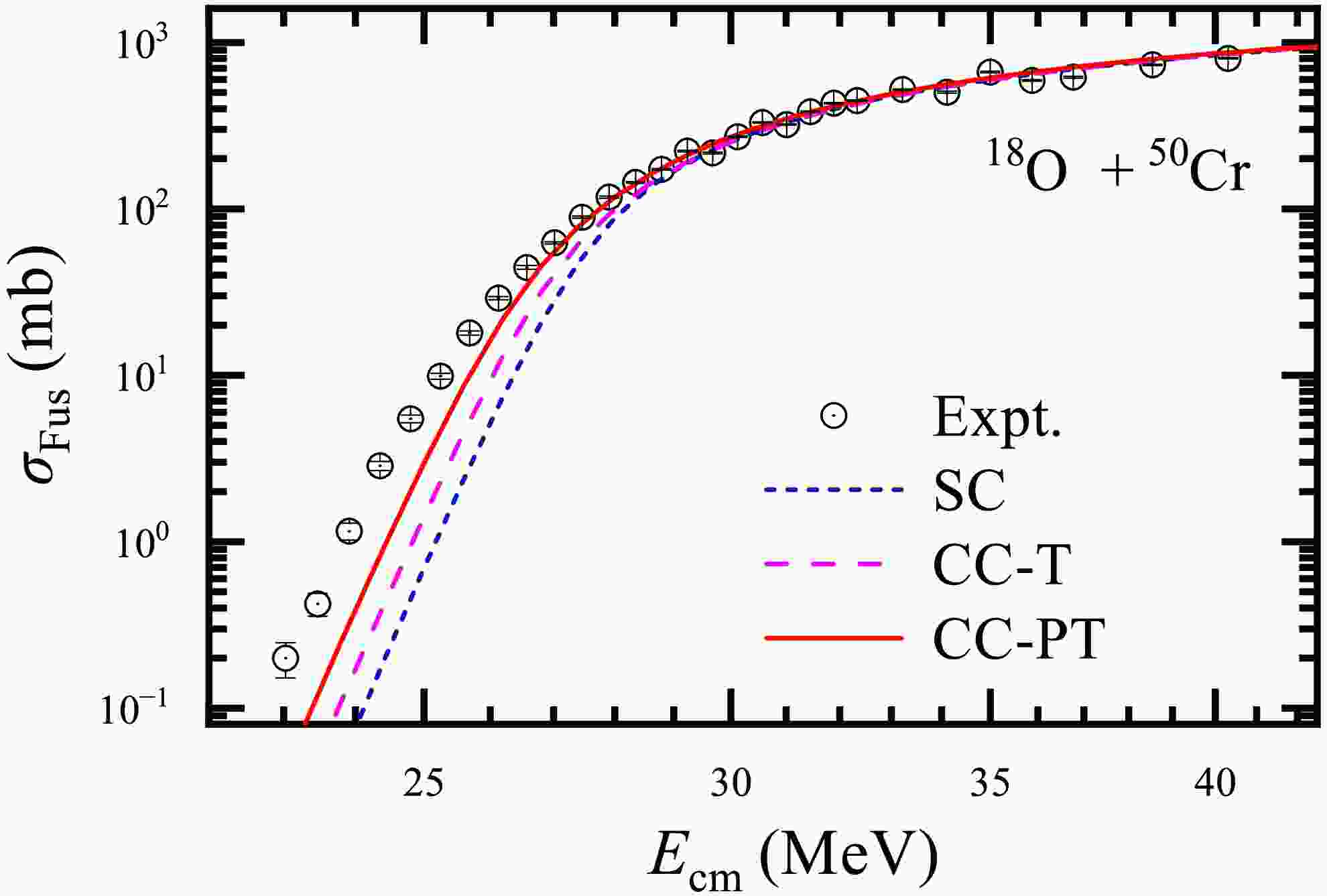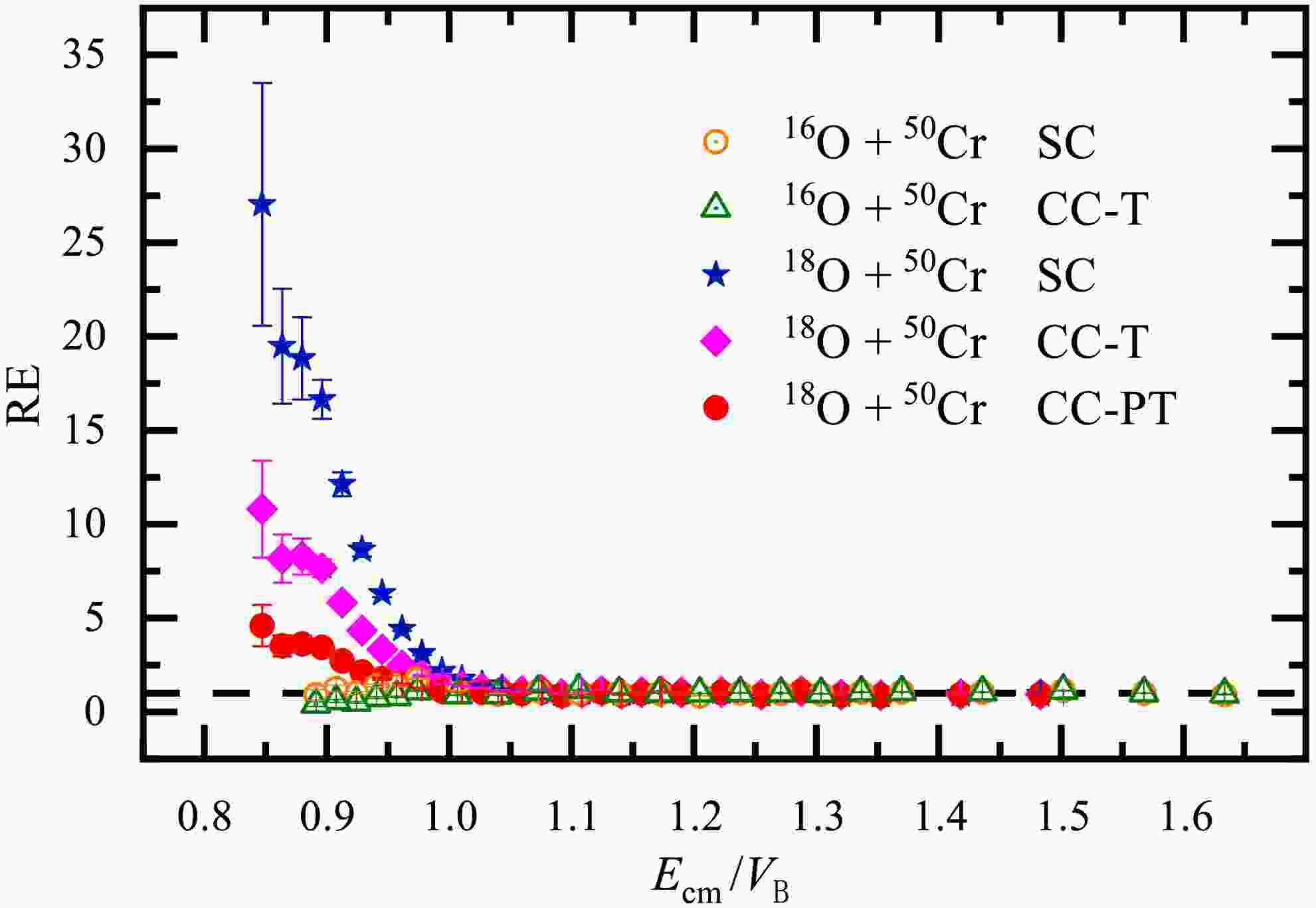-
Heavy-ion fusion at energies near and below the Coulomb barrier (
$ V_{\mathrm{B}} $ ) is connected to the basic quantum problems of tunneling and the coupled channels (CC) effect, wherein the CC effect is the kernel problem in sub-barrier heavy-ion fusion, as considered in many branches of physics and chemistry [1]. The fusion mechanism of heavy ions is also related to super-heavy element synthesis and celestial phenomena, such as super-ray bursts occurring in neutron star crusts [2]. Therefore, this has always been a hot topic of both experimental and theoretical research [3−13], since the discovery of the so-called sub-barrier fusion enhancement (up to a few orders of magnitude) due to the static deformation effect in 1978 [11].Heavy-ion fusion is the complete amalgamation of a projectile into the target nucleus, with equilibration in all degrees of freedom, to form an excited compound nucleus (CN). Complete fusion above the barrier can be explained by a classical Weisskopf formulation [14, 15]. The classical formula for fusion cross-section (
$ \sigma_{\mathrm{Fus}} $ )$ \sigma_{\mathrm{Fus}} $ =$ \pi R_{\mathrm{B}}^2 $ (1 -$ V_{\mathrm{B}} $ /$ E_{\mathrm{cm}} $ ) was used to extract barrier height$ V_{\mathrm{B}} $ and position$ R_{\mathrm{B}} $ using the measured fusion cross-sections of the non-heavy tightly-bound systems at energies well above the barrier [16].For lighter systems, the sub-barrier fusion process can be roughly seen as an inverse process of α-decay [17, 18] or low-energy fission using the Hill-Wheeler penetration formula based on the proposed parabolic potential shape [19]. Later, Wong's formula was proposed to calculate the near-barrier fusion cross-section with the Hill-Wheeler penetration formula, considering the static deformation of the reactants [20]. All the ideas mentioned above belong to the category of one-dimensional barrier penetration models (1D-BPMs).
When the reaction system becomes heavier, the CC effect becomes dominant in sub-barrier fusion. As is well known, sub-barrier fusion cross-section is generally mediated by strong couplings to nuclear rotational states [21], vibrational states [22], and nucleon transfer [23], which is a phenomenon of coupling-aided tunneling. The couplings could lead to barrier splitting and then form a multi-dimensional barrier distribution [24], wherein the reduced barrier lower than the original single-barrier corresponds to the increased fusion cross-section. Up to now, the effect of coupling on transfer channels is still not consistent experimentally. At the same time, it is still difficult to take this effect into account self-consistently in theory although the microscopic theories of coupled reaction channels [25] and time-dependent Hartree-Fock [26] have been used to consider the effect of nucleon transfers in calculating the fusion cross-sections.
The CC effect potentially correlated to nucleon transfers was first discovered in
$ ^{58} {\rm{Ni}}$ +$ ^{64} {\rm{Ni}}$ using a comparative experimental study on the$ ^{58,64} {\rm{Ni}}$ +$ ^{58,64} {\rm{Ni}}$ systems, which set a precedent to extract the nucleon transfer effect experimentally [27]. A kinematic neutron-transfer Q-value effect was then proposed to explain the enhancement in a model-independent manner [23], wherein the intermediate positive Q-value neutron transfer (PQNT) channels and indistinguishable effective ground-state positive Q-value ($ Q^{\mathrm{eff}} $ ) proton transfer (PQPT) channels could increase the penetrability in the two-step non-dynamical picture.$ Q^{\mathrm{eff}} $ is the ground-state Q-value plus the Coulomb-barrier difference between the incoming channel ($ V_{\mathrm{B}}^{\mathrm{in}} $ ) and intermediate transfer channel ($ V_{\mathrm{B}}^{\mathrm{tr}} $ ), that is,$ Q^{\mathrm{eff}} $ =$ Q^{\mathrm{gs}} $ + ($ V_{\mathrm{B}}^{\mathrm{in}} $ -$ V_{\mathrm{B}}^{\mathrm{tr}} $ ).Considering the large neutron transfer cross-section at near-barrier energies, the prevailing view is that coupling to positive Q-value neutron transfer channels should play an important role in sub-barrier fusion of a heavier system such as
$ ^{40} {\rm{Ca}}$ +$ ^{48} {\rm{Ca}}$ [28, 29] and$ ^{40} {\rm{Ca}}$ +$ ^{96} {\rm{Zr}}$ [30]. However, the systems that were once claimed to have strong neutron transfer effect, such as$ ^{40} {\rm{Ca}}$ +$ ^{48} {\rm{Ca}}$ ,$ ^{96} {\rm{Zr}}$ , and$ ^{58} {\rm{Ni}}$ +$ ^{64} {\rm{Ni}}$ , also have effective ground-state positive Q-value two-proton stripping channels (+7.57 MeV, +7.96 MeV, +2.66 MeV). The potential role of proton stripping in sub-barrier fusion enhancement should not be arbitrarily ignored, as proposed in Ref. [31]. The definitions of "pickup" and "stripping" reactions are conventionally given in terms of transfer to or from the lighter partner of the two reactants in the reaction [32]. Therefore, despite many experimental and theoretical [33−40] studies, the dynamics of neutron-transfer-mediated sub-barrier fusion has not yet been well revealed [6]. From the above analysis, studying the fusion of systems without such proton-stripping channels is helpful to unveil the critical reaction mechanism.Neutron-rich
$ ^{18} {\rm{O}}$ -induced fusion is an ideal selection [41−45] for this type of study considering the positive Q-value neutron stripping due to the N = 8 magic number of the$ ^{16} {\rm{O}}$ core and inhibited proton-stripping due to both p-shell closure for Z = 8 magic number. The$ ^{18} {\rm{O}}$ projectile can be seen as a core plus two loosely-bound valence neutrons in a "di-neutron" configuration outside the tightly bound$ ^{16} {\rm{O}}$ core [46]. Therefore,$ ^{18} {\rm{O}}$ can be considered as a good neutron pair reservoir to excite the target pairing vibration modes [47, 48, 49] and may lead to a 2n-transfer cross-section as high as 1n-transfer [50]. The earlier measurement for the fusion of$ ^{18} {\rm{O}}$ +$ ^A {\rm{Sn}}$ and our measured$ ^{18} {\rm{O}}$ +$ ^{74} {\rm{Ge}}$ show no enhancement [42, 44], Meanwhile, the fusion of$ ^{18} {\rm{O}}$ +$ ^{58} {\rm{Ni}}$ was claimed to show obvious enhancement [51] and was once used as a benchmark for theories [38]. To further study the fusion behavior of$ ^{18} {\rm{O}}$ -induced systems with larger positive Q-value 2n transfer channels and establish a systematic evolution of this effect, further measurements for the fusion of$ ^{18} {\rm{O}}$ with different target nuclei are necessary.Usually, to single out the collective excitations and highlight the nucleon transfer effect, systems with lower
$ Z_{\mathrm{P}} $ $ Z_{\mathrm{T}} $ (weak inelastic coupling effect) and large ground state Q-values for nucleon transfers are ideal for obtaining quantitative information. This is the case for the 1n and 2n stripping channels, whose exothermic Q-values are +1.22 and +9.11 MeV for$ ^{18} {\rm{O}}$ +$ ^{50} {\rm{Cr}}$ . This system, with both high$ Q^{\mathrm{gs}}_{-2n} $ -value +9.11 MeV and$ Q^{\mathrm{gs}}_{-2n} $ /$ V_{\mathrm{B}} $ $ \sim $ 0.33, was measured to highlight its potential role at energies near and below the Coulomb barrier. The fusion of$ ^{16} {\rm{O}}$ +$ ^{50} {\rm{Cr}}$ , without positive Q-value neutron transfers, was also measured as a reference. -
The collimated
$ ^{16,18} {\rm{O}}$ (charge state q = 5$ ^+ $ ) beams were delivered at intensities ranging from 2 to 20 pnA by the HI-13 tandem accelerator at the China Institute of Atomic Energy (CIAE), Beijing. Measurements of the fusion evaporation residuals (ER) by using an electrostatic deflector [52] have been conducted for the$ ^{16,18} {\rm{O}}$ +$ ^{50} {\rm{Cr}}$ reactions at energies near and below the Coulomb barriers. The beam energies for collimated$ ^{16} {\rm{O}}$ were varied from 33 MeV (0.89$ V_{\mathrm{B}} $ ) to 60 MeV (1.63$ V_{\mathrm{B}} $ ) and for collimated$ ^{18} {\rm{O}}$ from 31 MeV (0.84$ V_{\mathrm{B}} $ ) to 55 MeV (1.48$ V_{\mathrm{B}} $ ), with larger steps 2.4$ / $ 1.2 MeV at higher energies and a smaller step 0.6 MeV at lower energies. The adjustments were made exclusively in a downward direction, starting from the highest energy, to minimize magnetic hysteresis. The$ ^{50} {\rm{Cr}}$ target, which is 97.40% isotope enriched with a diameter of 3 mm and thickness 70 μg/cm2, was sputtered onto carbon foils with a thickness of 23 μg/cm2. Four Si detectors were symmetrically positioned at the forward angle of$ \pm 17 ^\circ $ relative to the beam direction covering both the right-left and up-down orientations, to measure Rutherford scattering to monitor the beam condition and normalize the fusion cross-section.ER was effectively separated from the beam-like particles (BLP) at forward angles, relative to the beam direction, based on the electrical rigidity E/q of the reaction products by using two pairs of electrodes. The reaction products corresponding to an opening angle of
$ \theta_{\mathrm{lab}} $ =$ \pm 0.38 ^\circ $ can enter the electric field region, selected by an entrance collimator with a diameter of 2.5 mm at a distance of 19.0 cm downstream of the target. A carbon foil with a thickness of 10 μg/cm2 on the collimator was employed to reset the atomic charge state distribution through the internal conversion process along the ion path. Subsequently, they were identified via the two-dimensional E vs time-of-flight (ToF) spectrum, wherein the detector telescope consisted of two microchannel plate (MCP) detectors for measuring ToF and a quadrant silicon detector with an active area of 50$ \times $ 50 mm2 for energy measurements. The quadrant silicon detector was used also for monitoring the spatial distribution of ER and hence ensuring the optimum electric field was used. A typical two-dimensional E-ToF spectrum was used to separate the ER from the BLP-products measured at 3$ ^\circ $ for the$ ^{18} {\rm{O}}$ +$ ^{50} {\rm{Cr}}$ system at$ E_{\mathrm{lab}} $ = 36.74 MeV (0.99$ V_{\mathrm{B}} $ ), as shown in Fig. 1, wherein the ER and BLP can be clearly distinguished.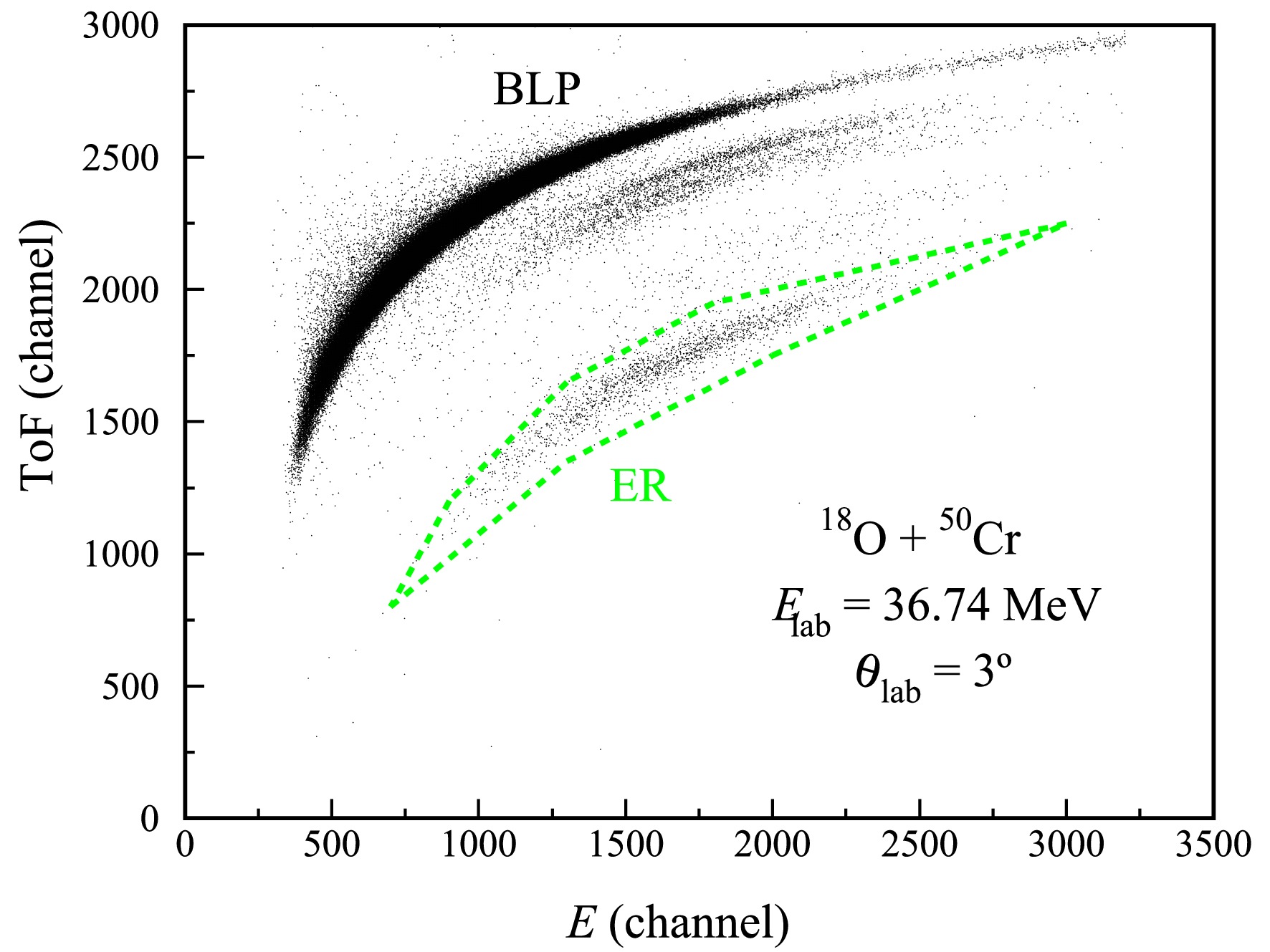
Figure 1. (color online) Typical two-dimensional E-ToF spectrum for separating the ER from the scattered beam-like products measured at
$3^\circ$ for the$^{18}{\rm{O}}$ +$^{50}{\rm{Cr}}$ system at$E_{\mathrm{lab}}$ = 36.74 MeV (0.99$V_{\mathrm{B}}$ ). The group of ER corresponds to fusion evaporation residue events, and BLP represents beam-like particles.The angular distributions of the ER were measured for
$ ^{18} {\rm{O}}$ +$ ^{50} {\rm{Cr}}$ at$ E_{\mathrm{lab}} $ = 47.59 and 38.55 MeV over$ \theta_{\mathrm{lab}} $ = –5$ ^\circ $ -13$ ^\circ $ with steps of$ \theta_{\mathrm{lab}} $ = 1$ ^\circ $ or 2$ ^\circ $ , as shown by the points with sole representation of the statistical errors in Fig. 2, wherein the error bar is smaller than the symbol size. The lines correspond to the Gaussian fits. Because the fission of the excited CN can be neglected for such light systems, the measured ER cross sections$ \sigma_{\mathrm{ER}} $ are equal to$ \sigma_{\mathrm{Fus}} $ . The total fusion cross-section$ \sigma_{\mathrm{Fus}} $ is derived by integrating the angular distributions, wherein corrections were made for the transmission efficiency.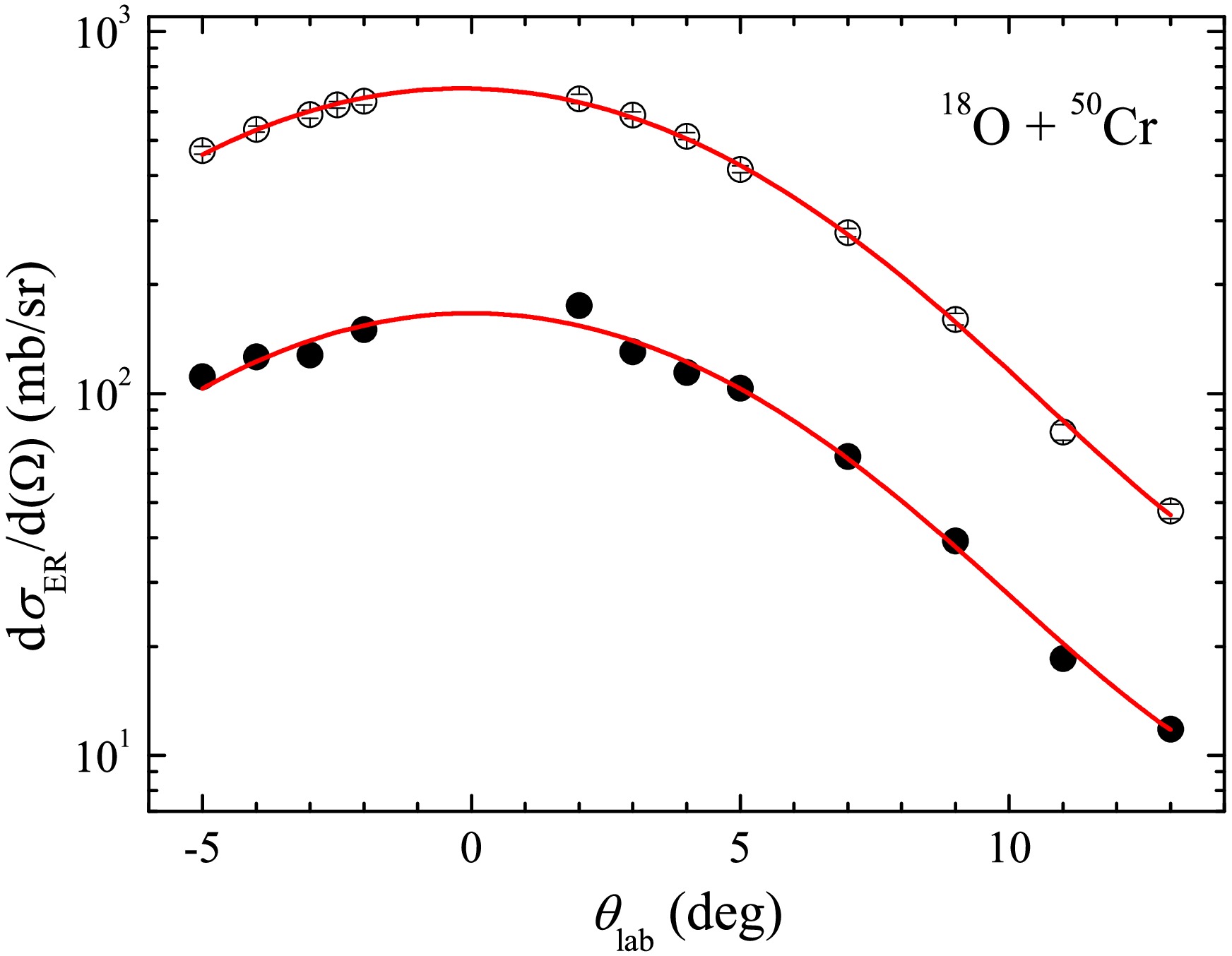
Figure 2. (color online) Angular distributions of the ER measured for
$^{18}{\rm{O}}$ +$^{50}{\rm{Cr}}$ at$E_{\mathrm{lab}}$ = 47.59 (hollow circles) and 38.55 MeV (solid circles). The error bars are purely from statistics and usually smaller than the point size. The two curves are the Gaussian fits.The two measured angular distributions show a small variation in shape with energy, characterized by a full width at half maximum (FWHM) of the Gaussian fit that decreases from 12.1
$ ^\circ $ to 11.7$ ^\circ $ . These distributions are in accordance with the predictions by the code PACE2 [53]. Therefore, the theoretical angular distributions were employed to calculate$ \sigma_{\mathrm{Fus}} $ for other energies, utilizing the measured fusion differential cross-sections at a certain angle. More details can be found in Ref. [52]. -
The integrated fusion cross-sections for the
$ ^{16} {\rm{O}}$ +$ ^{50} {\rm{Cr}}$ and$ ^{18} {\rm{O}}$ +$ ^{50} {\rm{Cr}}$ systems as a function of the center-of-mass frame energy ($ E_{\mathrm{cm}} $ ) are shown as hollow points in Figs. 3 and 4. The energy has been corrected to account for the energy loss in targets and carbon backing (faced to the beams). The statistical uncertainties are approximately ±1.0% for the higher and intermediate energy points, increasing to approximately ±31% for the lowest energy point.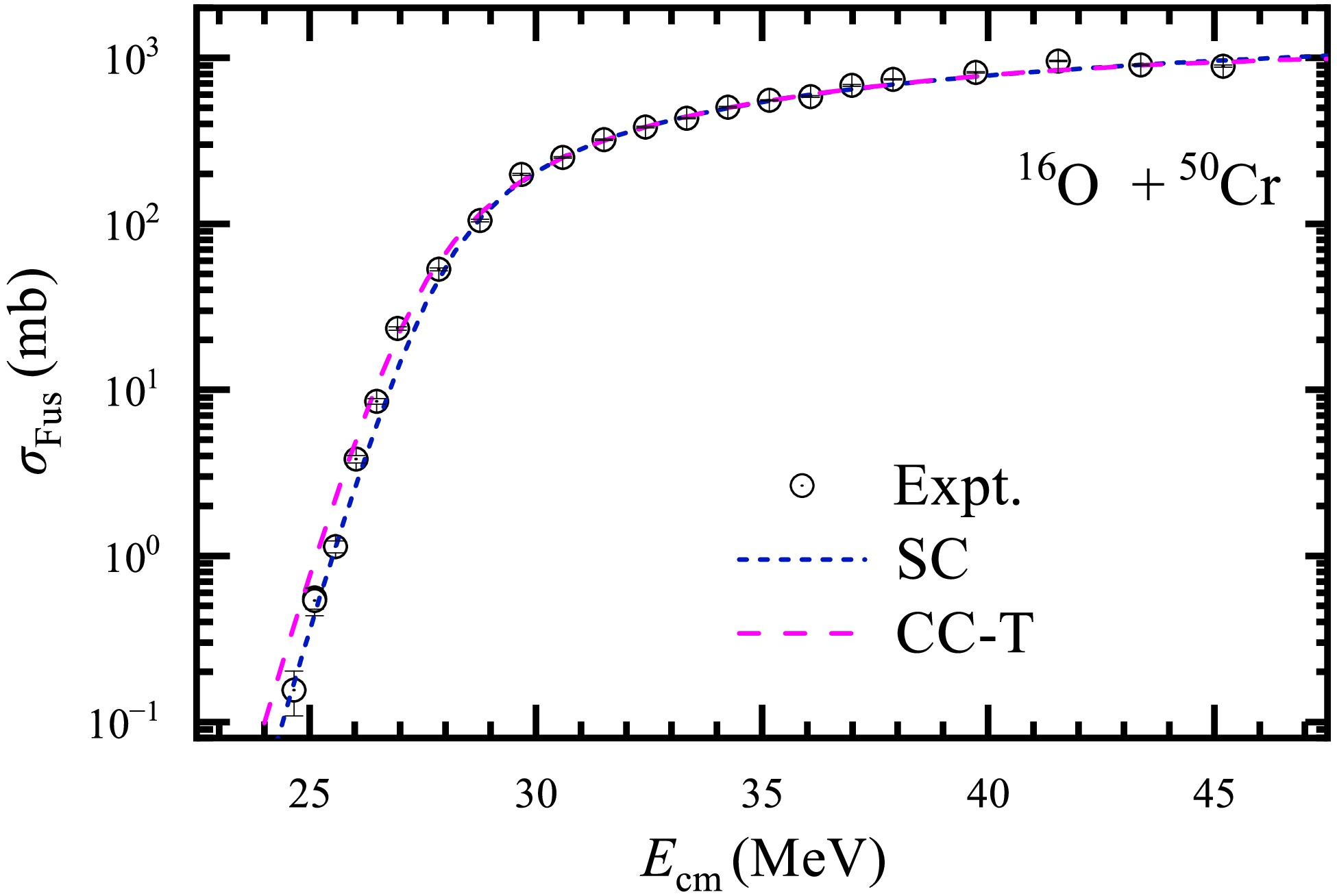
Figure 3. (color online) Experimental fusion excitation function (hollow circles) and calculated results for the
$^{16}{\rm{O}}$ +$^{50}{\rm{Cr}}$ system.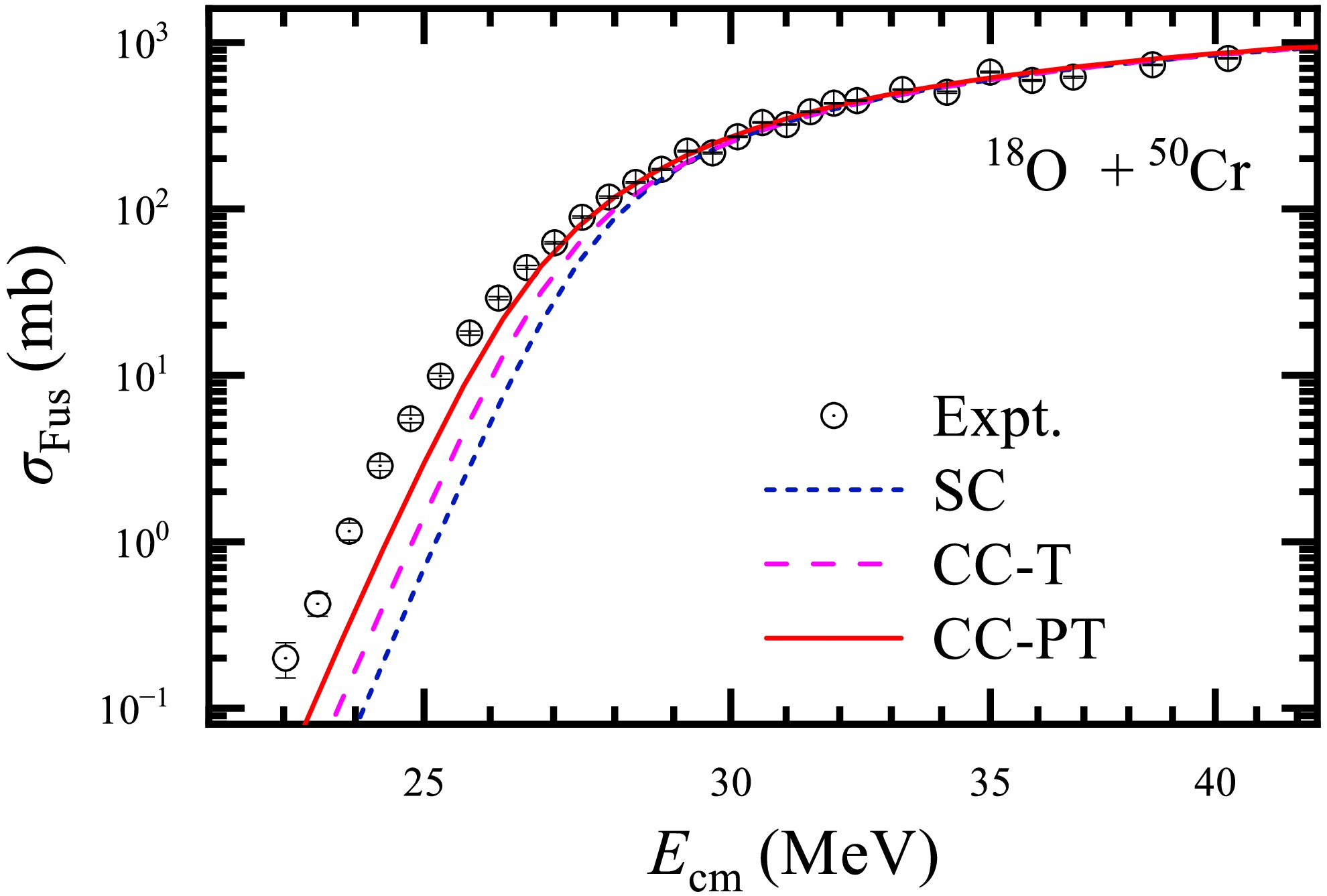
Figure 4. (color online) Experimental fusion excitation function (hollow circles) and calculated results for the
$^{18}{\rm{O}}$ +$^{50}{\rm{Cr}}$ system.Analysis of the fusion data was conducted using the code CCFULL [54], which incorporates all-order nonlinear couplings and uses the incoming wave boundary condition at the minimum of the potential pocket (inside the Coulomb barrier). The excitation energies
$ E_{\mathrm{x}} $ , spins and parities$ \lambda^{\pi} $ , and deformation parameters$ \beta_{\lambda} $ [55, 56] of the low-lying collective excitation states for$ ^{16,18} {\rm{O}}$ and$ ^{50} {\rm{Cr}}$ are listed in Table 1. The effects of coupling to low-lying collective excitation states of the reactants were considered, and the standard Akyüz-Winther (AW) nuclear potential [57] was adopted here. The corresponding parameters together with those of the uncoupled potentials used in the present CC calculations are reported in Table 2.Nucleus $E_{\mathrm{2^+}}$ /MeV

$\beta_2$ 

$E_{\mathrm{3^-}}$ /MeV

$\beta_3$ 

$^{16}{\rm{O}}$ 

6.130 $^{18}{\rm{O}}$ 

1.982 0.355 $^{50}{\rm{Cr}}$ 

0.783 0.293 4.052 0.095 System $V_0$ /MeV

$R_0$ /fm

a/fm $V_{\mathrm{B}}$ /MeV

$R_{\mathrm{B}}$ /fm

ħω/MeV $^{16}{\rm{O}}$ +

$^{50}{\rm{Cr}}$ 

52.713 1.171 0.631 27.723 9.268 3.700 $^{18}{\rm{O}}$ +

$^{50}{\rm{Cr}}$ 

53.879 1.171 0.635 27.256 9.437 3.480 Table 2. Parameters of the Akyüz-Winther potential [57] and barrier heights, radii, and curvatures of the uncoupled potentials for
$^{16,18}{\rm{O}}$ +$^{50}{\rm{Cr}}$ employed in the CC calculations.The first excitation state
$ 3^- $ of$ ^{16} {\rm{O}}$ with higher excitation energy 6.13 MeV, larger than the barrier curvature, should not be explicitly taken into account in the CC calculations due to the adiabatic effect [58, 59]. The nucleus of$ ^{50} {\rm{Cr}}$ exhibits excellent vibrational characteristics, with its lowest 2$ ^+ $ state located at 783.3 keV. For the$ ^{16} {\rm{O}}$ +$ ^{50} {\rm{Cr}}$ system without positive Q-value nucleon transfer channels, the result of the single-channel (SC) calculation is depicted by the short-dashed line in Fig. 3. The calculations incorporating the low-lying vibrational 2$ _1^+ $ one-phonon state of$ ^{50} {\rm{Cr}}$ (CC-T), without considering coupling to the collective excitations of$ ^{16} {\rm{O}}$ , is represented by the long-dashed line. The results indicate that both the SC and CC-T calculations reproduce the fusion excitation function relatively well within the experimental uncertainties, consistent with the expected smaller role of coupling to inelastic channels due to the smaller coupling strength β$ Z_{\mathrm{P}} $ $ Z_{\mathrm{T}} $ for the lighter systems.For the
$ ^{18} {\rm{O}}$ +$ ^{50} {\rm{Cr}}$ system, the results of the SC calculation (short-dashed line) obviously underestimate the sub-barrier fusion cross-sections, as shown in Fig. 4. The CC calculated result CC-T (long-dashed line), which includes the 2$ _1^+ $ one-phonon state of$ ^{50} {\rm{Cr}}$ , is still lower than the experimental result at energies below the barrier. The CC calculated result CC-PT (solid line), further including the 2$ _1^+ $ one-phonon state of$ ^{18} {\rm{O}}$ , is still, but very modestly, lower than the experimental ones at energies below the barrier, leaving little room for other effects mostly related to nucleon transfers for$ ^{18} {\rm{O}}$ +$ ^{50} {\rm{Cr}}$ or couplings to multi-phonon states [60].It is important to note that the
$ ^{16} {\rm{O}}$ +$ ^{50} {\rm{Cr}}$ system, which is expected to have no PQNT effects, can be used as a benchmark. The calculation scheme for the inelastic coupling channels of$ ^{50} {\rm{Cr}}$ in the$ ^{18} {\rm{O}}$ +$ ^{50} {\rm{Cr}}$ system is the same as that for the$ ^{16} {\rm{O}}$ +$ ^{50} {\rm{Cr}}$ system, allowing for a more reliable comparison of the residual enhancement (RE) due to the nucleon transfer effect, which was defined as the ratio of the experimental fusion cross-section to the calculated one, expressed as RE =$ \sigma_{\mathrm{Expt}} $ /$ \sigma_{\mathrm{CC}} $ [61]. The variation of RE with the reduced energy$ E_{\mathrm{cm}} $ /$ V_{\mathrm{B}} $ for the$ ^{16,18} {\rm{O}}$ +$ ^{50} {\rm{Cr}}$ systems is shown in Fig. 5. For the$ ^{16} {\rm{O}}$ +$ ^{50} {\rm{Cr}}$ system, RE for both the SC (hollow circles) and CC-T (hollow triangles) calculations almost remain at unity across the whole measured energy region, representing a good reference for highlighting the coupling effect to neutron transfer channels in the fusion of$ ^{18} {\rm{O}}$ +$ ^{50} {\rm{Cr}}$ . For$ ^{18} {\rm{O}}$ +$ ^{50} {\rm{Cr}}$ , all the SC (stars), CC-T (diamonds), and CC-PT (solid circles) calculated results deviate from unity at energies below the Coulomb barrier. Meanwhile, the RE of CC-PT calculation shows only subtle deviation, meaning negligible potential role of the positive Q-value 2n-stripping channel effect in the measured sub-barrier energy region despite its high$ Q^{\mathrm{gs}}_{-2n} $ -value and$ Q^{\mathrm{gs}}_{-2n} $ /$ V_{\mathrm{B}} $ -value for$ ^{18} {\rm{O}}$ +$ ^{50} {\rm{Cr}}$ . -
The present comparative study for
$ ^{16,18} {\rm{O}}$ +$ ^{50} {\rm{Cr}}$ suggests that the positive Q-value 2n-stripping channel in$ ^{18} {\rm{O}}$ +$ ^{50} {\rm{Cr}}$ does not enhance the sub-barrier fusion cross-sections substantially. This result agrees well with the systematic behavior of no remarkable role of the positive Q-value 2n-stripping channel in the sub-barrier fusion of the$ ^{18} {\rm{O}}$ -induced systems like$ ^{18} {\rm{O}}$ +$ ^A {\rm{Sn}}$ [42],$ ^{92} {\rm{Mo}}$ [43],$ ^{74} {\rm{Ge}}$ [44]. This conclusion is consistent with the argument that the neutron transfer enhances the sub-barrier fusion cross-section only in the case of increased deformation of the intermediate transfer-channel residual nuclei in relation to that of the initial reactants based on the quantum diffusion approach [39]. This argument was obtained based essentially on a sequential fusion picture of two-step reaction processes like the models used in Refs. [23, 38]. However, this model alone cannot explain the insignificant enhancement for$ ^{36} {\rm{S}}$ +$ ^{58} {\rm{Ni}}$ assisted by positive Q-value 2n-stripping [62], which has an increased deformation after 2n transfer, that is$ ^{36} {\rm{S}}$ ($ \beta_2 $ = 0.168) +$ ^{58} {\rm{Ni}}$ ($ \beta_2 $ = 0.183)$ \rightarrow $ $ ^{34} {\rm{S}}$ ($ \beta_2 $ = 0.257) +$ ^{60} {\rm{Ni}}$ ($ \beta_2 $ = 0.207) [55]. This suggests that other mechanisms should play a role in the sub-barrier fusion of heavy-ions.From the viewpoint of CC [31], these consistent systematics remind us of re-evaluating the potential role of coupling to the proton-stripping channel [63] with effective ground-state Q-value in enhancing sub-barrier fusion, considering the higher measured 2p-stripping cross-sections, such as for
$ ^{32} {\rm{S}}$ +$ ^{64} {\rm{Ni}}$ , even at low energy very near the barrier [63]. This potential proton-stripping effect was once proposed in the pioneering explanation of the isotopic effect in the sub-barrier fusion of$ ^{58} {\rm{Ni}}$ +$ ^{64} {\rm{Ni}}$ [23], later for$ ^{32} {\rm{S}}$ +$ ^{64} {\rm{Ni}}$ [63], and in recent work for$ ^{40} {\rm{Ca}}$ +$ ^{96} {\rm{Zr}}$ [31]. The present results further highlight the complicated mechanisms of sub-barrier heavy-ion fusion, and further experimental and theoretical studies are required. -
In summary, we measured the fusion excitation functions of
$ ^{16,18} {\rm{O}}$ +$ ^{50} {\rm{Cr}}$ at energies near the Coulomb barrier to study the fusion dynamics. Compared to the CC calculated results, the sub-barrier fusion of$ ^{18} {\rm{O}}$ +$ ^{50} {\rm{Cr}}$ shows no remarkable 2n-stripping coupling effect. The RE analysis for$ ^{18} {\rm{O}}$ +$ ^{50} {\rm{Cr}}$ gives a quantitative result for this insignificant 2n-stripping effect below the barrier despite the high$Q^{\mathrm{gs}}_{-2{n}}$ -value and$Q^{\mathrm{gs}}_{-2{n}}$ /$ V_{\mathrm{B}} $ -value, compared to few-order enhancement found in some systems with positive Q-value neutron pickup channels below the barrier. Combined with the previous data of$ ^{18} {\rm{O}}$ +$ ^A {\rm{Sn}}$ ,$ ^{92} {\rm{Mo}}$ ,$ ^{74} {\rm{Ge}}$ , a systematic behavior of no fusion enhancement due to positive Q-value 2n-stripping, across a wide atomic number of the target nuclei, high$Q^{\mathrm{gs}}_{-2{n}}$ -value up to +9.11 MeV, and high$Q^{\mathrm{gs}}_{-2{n}}$ /$ V_{\mathrm{B}} $ -value up to 1/3, has been established. More studies are required to further confirm this conclusion.This systematic conclusion could further refresh the popular argument of sub-barrier fusion enhancement due to positive Q-value 2n transfer in recent decades and will help to improve the models for clarifying the complicated sub-barrier fusion dynamics in the end. A more sophisticated consideration, such as in a microscopic time-dependent Hartree-Fock theory for consistently describing both the neutron transfer and proton transfer, is required for a final understanding of the complicated sub-barrier fusion dynamics of heavy ions.
Near-barrier fusion of 16,18O + 50Cr: the role of positive Q-value two-neutron stripping channel
- Received Date: 2025-01-25
- Available Online: 2025-06-15
Abstract: To study the coupling effect of the positive Q-value two-neutron stripping channel in the sub-barrier of





 Abstract
Abstract HTML
HTML Reference
Reference Related
Related PDF
PDF





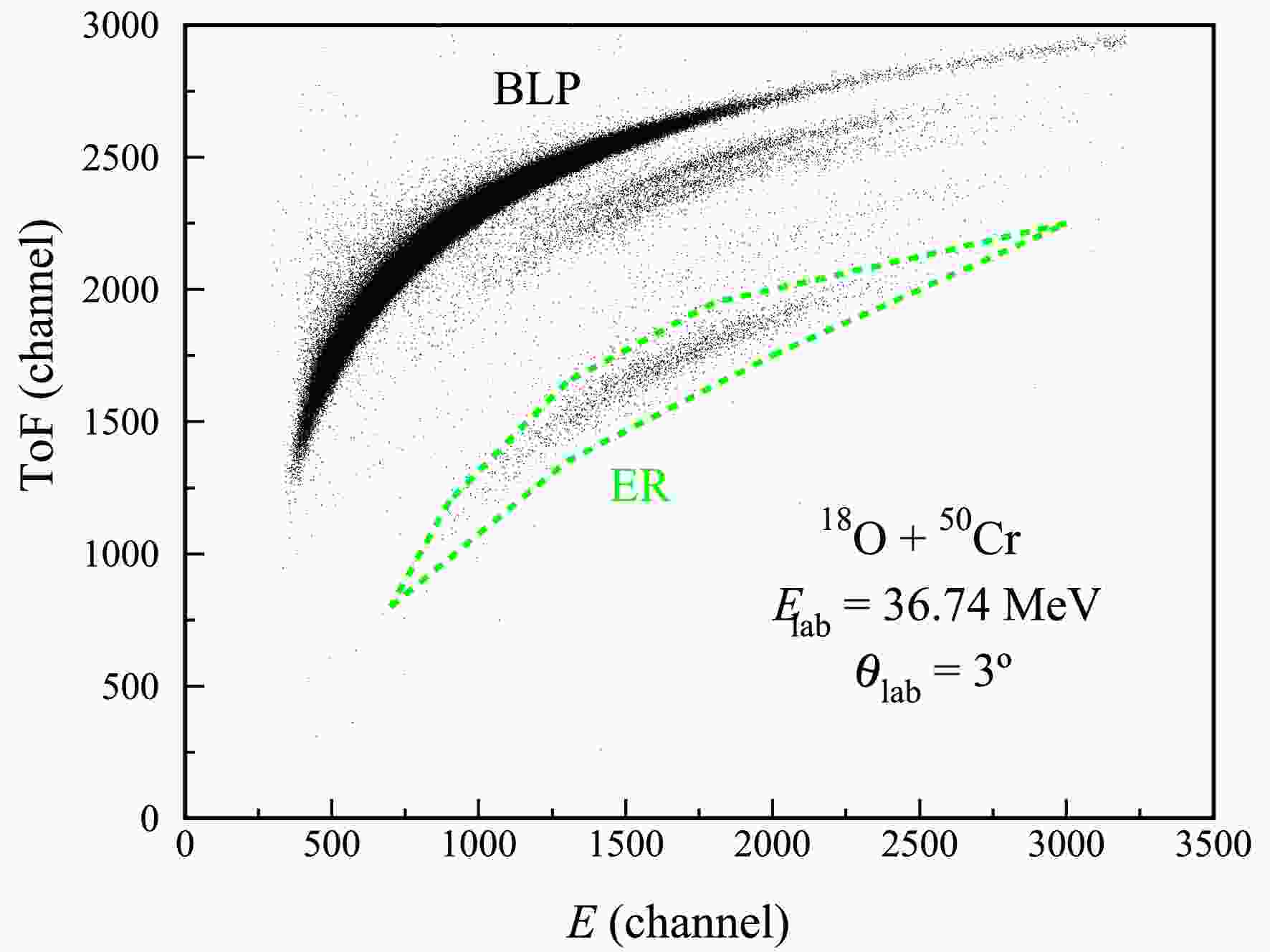










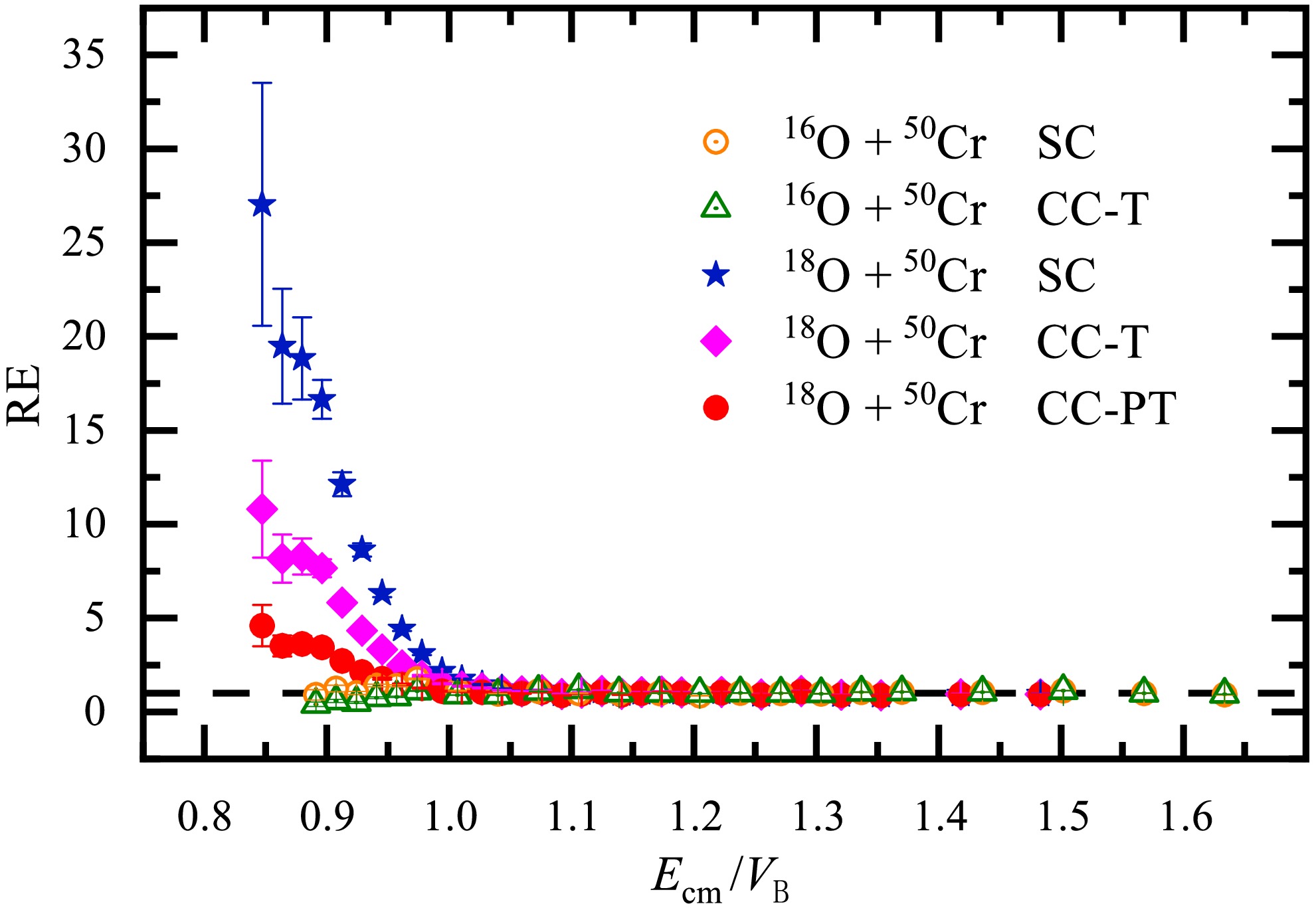



 DownLoad:
DownLoad:
